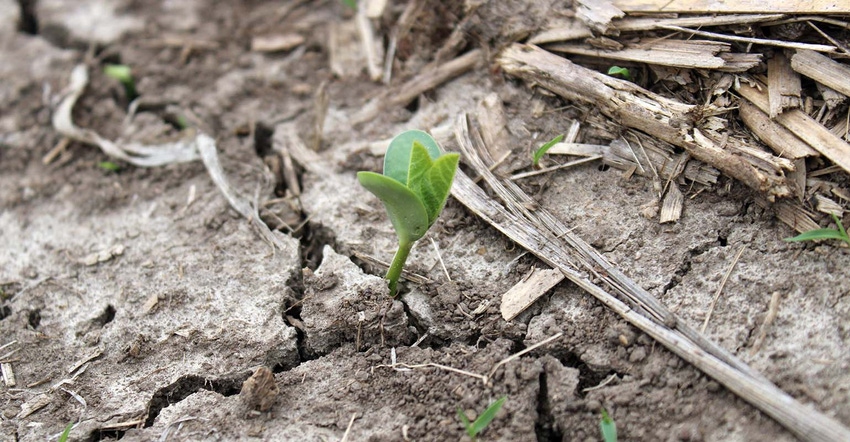
The planting pace of corn and soybeans remains behind normal this spring. Monday afternoon’s crop progress report showed the U.S. corn crop was only 49% planted, well behind the 5-year average pace of 67%.
The U.S. soybean crop was only 30% planted, well behind the 5-year average pace of 39%. This slower pace has helped to keep new crop grain prices propped up at lofty levels overall.
And while likely this week, a good portion of the Midwest will have had substantial improvement in overall spring planting, two states clearly stick out as well behind normal pace: North Dakota and Minnesota.
As of Monday’s crop progress report, North Dakota was just 4% planted for corn (normally 41%) and only 2% planted for soybeans (normally 24%). Minnesota was 35% planted for corn (normally 72% planted) and only 11% planted for soybeans (normally 47% planted on a 5-year average).
You may be tempted to shrug your shoulders and think, “Who cares? They will catch up eventually.” But that is the wrong mindset in this year’s environment. We need all of those acres to get planted and planted quickly.
Minnesota and North Dakota matter
Based on data from the March 31 Prospective Plantings report, it is suggested that North Dakota will plant 3.6 million acres of corn while Minnesota is expected to plant 7.8 million acres of corn. Combined, that equals 11.4 million acres of corn of the 89.49 million planted corn acres expected this spring.
That means that nearly 13% of the entire U.S. corn crop is exceptionally behind on planting.
When looking at soybeans, North Dakota is expected to plant a whopping 7 million acres of soybeans while Minnesota is expected to plant an also large 8 million acres. Combined, that equates to 15 million acres. Overall U.S. soybean planted acres are pegged to be 90.955 million acres, so in this instance, nearly 16.5% of the total U.S. soybean crop is barely planted!
Exports at risk?
Most importantly, this is the corn and soybean crop that goes by rail to the Pacific Northwest and for export to Asia. According to the North Dakota Soybean Council, 71% of North Dakota soybeans are exported globally via the PNW.
Visiting with clients in those two states, not much additional fieldwork had been completed at the beginning of this week before the next round of rain came through. Many fields in North Dakota are still too soggy to plant. And the possibility of taking prevent plant is right around the corner. For some, they have suggested that taking prevent plant might be a more attractive option than mudding the crop in the ground, or then having to stress about marketing the crop in this volatile environment, especially not fully being confident in what that delayed crop could yield as it likely has lost the ability to become a record crop.
Regardless, this planting delay does two things; lessens the ability of the U.S. to have a record crop, or even reach the current USDA yield projections of 51.5 for soybeans and 177 for corn. It also obviously reduces the ability for an early harvest, which will then create a need to stretch the last of the old crop currently in bins, and delay critical shipments of exports to nations in need come fall.
The way that new crop corn and soybean futures have been trading, it seems as though those two commodities might know that there may need to be one final push higher for price, to give farmers that final incentive to get that crop in the ground in those northern states.
Reach Naomi Blohm at 800-334-9779, on Twitter: @naomiblohm, and at [email protected].
Disclaimer: The data contained herein is believed to be drawn from reliable sources but cannot be guaranteed. Individuals acting on this information are responsible for their own actions. Commodity trading may not be suitable for all recipients of this report. Futures and options trading involve significant risk of loss and may not be suitable for everyone. Therefore, carefully consider whether such trading is suitable for you in light of your financial condition. No representation is being made that scenario planning, strategy or discipline will guarantee success or profits. Any decisions you may make to buy, sell or hold a futures or options position on such research are entirely your own and not in any way deemed to be endorsed by or attributed to Total Farm Marketing. Total Farm Marketing and TFM refer to Stewart-Peterson Group Inc., Stewart-Peterson Inc., and SP Risk Services LLC. Stewart-Peterson Group Inc. is registered with the Commodity Futures Trading Commission (CFTC) as an introducing broker and is a member of National Futures Association. SP Risk Services, LLC is an insurance agency and an equal opportunity provider. Stewart-Peterson Inc. is a publishing company. A customer may have relationships with all three companies. SP Risk Services LLC and Stewart-Peterson Inc. are wholly owned by Stewart-Peterson Group Inc. unless otherwise noted, services referenced are services of Stewart-Peterson Group Inc. Presented for solicitation.
The opinions of the author are not necessarily those of Farm Futures or Farm Progress.
About the Author(s)
You May Also Like






